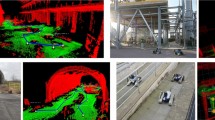Abstract
Multi-Agent Patrolling Problems consist in moving agents throughout a graph in order to optimize a collective performance metric. Some strategies from the literature tackle this problem by dispatching decentralized autonomous agents that coordinate themselves merely by sensing and writing information in the nodes. In this work, they are called k-range local strategies, were k indicates the range, in number of edges, of the agents’ sensing capabilities. The 1-range strategies (where agents can sense up to its neighbor nodes) are certainly the most common case in the literature. And only few 0-range strategies (where agents can only sense its current node) were found, although this type of strategy has the advantage of requiring simpler hardware, when applied in the design of real robots. In this work, we propose two higher-level procedures to reduce the perception range of 1-range strategies to 0: the Zr Method and the EZr Method. Applying both methods in 1-range strategies found in the literature, we created twenty new 0-range strategies, which were evaluated in a simulation experiment described and analyzed here. We also developed a prototype of a low-cost patrolling robot that is able to run the 0-range strategies proposed in this work.
Similar content being viewed by others
Explore related subjects
Discover the latest articles, news and stories from top researchers in related subjects.References
Almeida, A., Ramalho, G., Santana, H., Tedesco, P., Menezes, T., Corruble, V., Chevaleyre, Y.: Recent advances on multi-agent patrolling. In: Advances in Artificial Intelligence–SBIA 2004, pp. 474–483. Springer, Berlin (2004)
Baglietto, M., Cannata, G., Capezio, F., Sgorbissa, A.: Multi-robot uniform frequency coverage of significant locations in the environment. In: Distributed Autonomous Robotic Systems, vol. 8, pp. 3–14. Springer, Berlin (2009)
Cannata, G., Sgorbissa, A.: A minimalist algorithm for multirobot continuous coverage. IEEE Trans. Robot. 27(2), 297–312 (2011)
Chevaleyre, Y.: Theoretical analysis of the multi-agent patrolling problem. In: Proceedings. IEEE/WIC/ACM International Conference on Intelligent Agent Technology, 2004.(IAT 2004), pp. 302–308. IEEE (2004)
Chu, H.N., Glad, A., Simonin, O., Sempe, F., Drogoul, A., Charpillet, F.: Swarm approaches for the patrolling problem, information propagation vs. pheromone evaporation. In: 19th IEEE International Conference on Tools with Artificial Intelligence, 2007. ICTAI 2007, vol. 1, pp. 442–449. IEEE, New York (2007)
Elmaliach, Y., Agmon, N., Kaminka, G.A.: Multi-robot area patrol under frequency constraints. Ann. Math. Artif. Intell. 57(3–4), 293–320 (2009)
Elmaliach, Y., Shiloni, A., Kaminka, G.A.: A realistic model of frequency-based multi-robot polyline patrolling. In: Proceedings of the 7th International Joint Conference on Autonomous Agents and Multiagent Systems, vol. 1, pp. 63–70. International Foundation for Autonomous Agents and Multiagent Systems (IFAAMAS), Richland, USA. http://www.aamas-conference.org/Proceedings/aamas08/proceedings/mainTrackPapers.htm#t2 (2008)
Elor, Y., Bruckstein, A.M.: Multi-a (ge) nt graph patrolling and partitioning. In: Proceedings of the 2009 IEEE/WIC/ACM International Joint Conference on Web Intelligence and Intelligent Agent Technology, vol. 02, pp. 52–57. IEEE Computer Society, Washington, D.C. (2009)
Elor, Y., Bruckstein, A.M.: Autonomous multi-agent cycle based patro- lling. In: Swarm Intelligence, pp. 119–130. Springer, Berlin (2010)
Glad, A., Buffet, O., Simonin, O., Charpillet, F.: Self-organization of patrolling-ant algorithms. In: SASO’09. Third IEEE International Conference on Self-Adaptive and Self-Organizing Systems, 2009, pp. 61–70. IEEE, Berlin (2009)
Glad, A., Simonin, O., Buffet, O., Charpillet, F.: Theoretical study of ant-based algorithms for multi-agent patrolling. In: 18th European Conference on Artificial Intelligence including Prestigious Applications of Intelligent Systems (PAIS 2008)-ECAI 2008, pp. 626–630. IOS Press, Amsterdam (2008)
Koenig, S., Liu, Y.: Terrain coverage with ant robots: A simulation study. In: Proceedings of the Fifth International Conference on Autonomous Agents, pp. 600–607. ACM, New York (2001)
Koenig, S., Szymanski, B., Liu, Y.: Efficient and inefficient ant coverage methods. Ann. Math. Artif. Intell. 31(1-4), 41–76 (2001)
Machado, A., Ramalho, G., Zucker, J.D., Drogoul, A.: Multi-agent patrolling: An empirical analysis of alternative architectures. In: Multi-Agent-Based Simulation II, pp. 155–170. Springer, Berlin (2002)
Portugal, D., Rocha, R.P.: Distributed multi-robot patrol: A scalable and fault-tolerant framework. Robot. Auton. Syst. 61(12), 1572–1587 (2013)
Poulet, C., Corruble, V., Seghrouchni, A.E.F.: Working as a team: using social criteria in the timed patrolling problem. In: 2012 IEEE 24th International Conference on Tools with Artificial Intelligence (ICTAI), vol. 1, pp. 933–938. IEEE, New York (2012)
Sampaio, P.A., Ramalho, G., Tedesco, P.: The gravitational strategy for the timed patrolling. In: 2010 22nd IEEE International Conference on Tools with Artificial Intelligence (ICTAI), vol. 1, pp. 113–120. IEEE, New York (2010)
Sampaio, P.A., da S Sousa, R., Rocha, A.N.: New patrolling strategies with short-range perception. In: Proceedings of 13th IEEE Latin American Robotics Symposium and 4th Brazilian Robotics Symposium. IEEE Computer Society, New York (2016)
Svennebring, J., Koenig, S.: Building terrain-covering ant robots: A feasibility study. Auton. Robot. 16 (3), 313–332 (2004)
Wagner, I.A., Lindenbaum, M., Bruckstein, A.M.: Efficiently searching a graph by a smell-oriented vertex process. Ann. Math. Artif. Intell. 24(1-4), 211–223 (1998)
Yan, C., Zhang, T.: Multi-robot patrol a distributed algorithm based on expected idleness. Int. J.of Adv. Robot. Syst. 13(6), 1729881416663,666 (2016)
Yanovski, V., Wagner, I.A., Bruckstein, A.M.: A distributed ant algorithm for ∖ protect efficiently patrolling a network. Algorithmica 37(3), 165–186 (2003)
Author information
Authors and Affiliations
Corresponding author
Additional information
Research sponsored by FACEPE, project APQ-0882-1.03/4.
Rights and permissions
About this article
Cite this article
Azevedo Sampaio, P., da Silva Sousa, R. & Nazário Rocha, A. Reducing the Range of Perception in Multi-agent Patrolling Strategies. J Intell Robot Syst 91, 219–231 (2018). https://doi.org/10.1007/s10846-017-0697-0
Received:
Accepted:
Published:
Issue Date:
DOI: https://doi.org/10.1007/s10846-017-0697-0
Keywords
- Multi-agent patrolling
- Multi-robot patrolling
- Timed patrolling
- Frequency-based patrolling
- Patrolling strategies
- Local strategies
- K-range local strategies
- K-range strategies
- 0-range strategies
- Autonomous low-cost robot
- Maximum idleness
- Maximum interval
- Quadratic mean of the intervals
- Quadratic mean interval
- Standard deviation of frequencies
- RFID-based robot
- Perception range reduction




